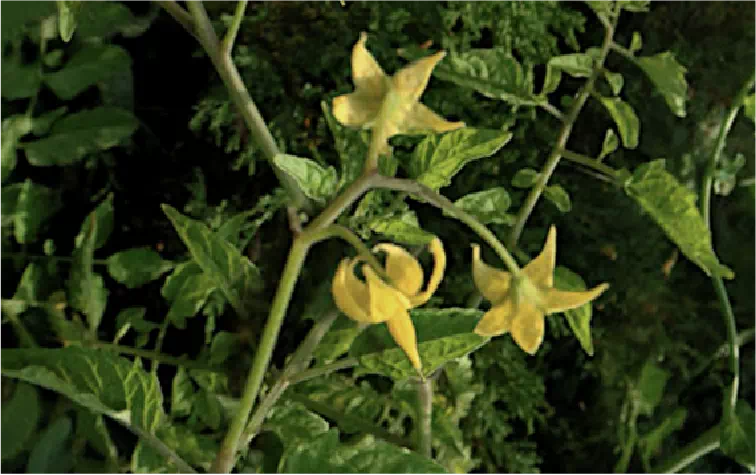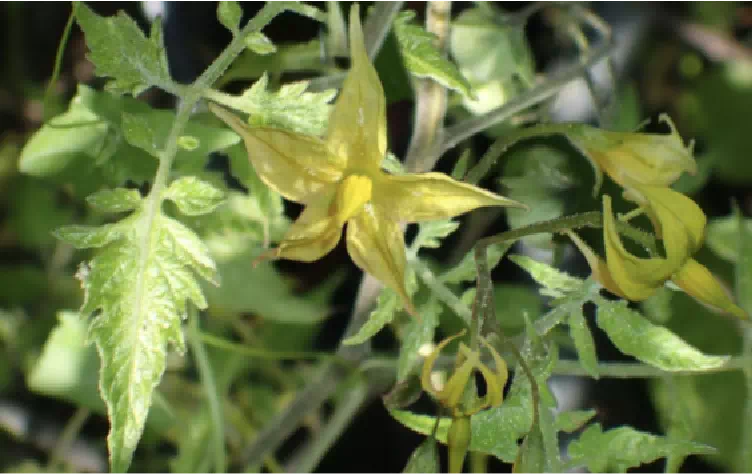Lycopersicon cerasiforme
Lycopersicon esculentum
Large fruits are typically red. Small flowers. Straight anther cone. Intergrades with S pimpinellifolium. Fully cross-compatible with other members of the Lycopersicon group. Self-compatible, sometimes with flowers that facilitate crossing. More dependent on moisture than other species.


Lycopersicon peruvianum var. parviflorum
Small fruits are yellow or orange. Regular-leaved. Small leaves, and plants. Small flowers. Straight anther cone. Stigma not exposed. Intergrades with S galapagense. Fully cross-compatible with other members of the Lycopersicon group. Strongly selfing. Endemic to all elevations in the Galapagos Islands.
Lycopersicon cheesmaniae f. minor
Very small fruits yellow or orange. Carrot-leaved. Bushy growth habit. Small flowers. Straight anther cone. Stigma not exposed. Intergrades with S cheesmaniae. Fully cross-compatible with other members of the Lycopersicon group. Strongly selfing. Endemic to low-elevation in the Galapagos Islands.


Lycopersicon esculentum ssp. intermedium
Lycopersicon esculentum ssp. pimpinellifolium
Small fruits are red. Regular-leaved. Small leaves, and plants. Small flowers. Deeply lobed petals are diagnostic for this species. Straight anther cone. Stigma exposed. Intergrades with S lycopersicum. Fully cross-compatible with other members of the Lycopersicon group. Self-compatible with flowers that facilitate crossing. Riparian adapted at low elevations in southern Ecuador and Peru.
Lycopersicon peruvianum var. humifusum
Fruits green with dark green stripes. Short fuzzy hairs on fruits. Simplified highly- serrated regular-leaf. Extremely variable species. Large flowers. Flower cluster unbranched. Straight anther cone. Exerted stigma. Intergrades with S chmielewskii and S neorickii. Usually self-incompatible. Dry habitat adapted. Some populations adapted to Lomas habitat. Low elevation near the coast and in river valleys.


Lycopersicon chmielewskii
Fruits are green with dark green stripes. Simplified serrated regular leaf. Intergrades with S arcanum and S neorickii. Large flowers. Flower cluster unbranched. Straight anther cone. Exerted stigma. Self-compatible with flowers that facilitate crossing. Dry habitat adapted. High elevations in south-central Peru to northern Bolivia.
Lycopersicon parviflorum
Fruits are green with dark green stripes. Simplified regular-leaf. Small dull flowers. Stigma not exposed. Flower cluster unbranched. Intergrades with S arcanum and S chmielewskii. Self-compatible. Strongly selfing. Dry habitat adapted. High elevations in southern Ecuador to south- central Peru. Descended from Solanum chmielewskii.


Lycopersicon peruvianum ssp. Puberulum
Fruits are green to whitish-green with purple stripes. Fern-leaved. Stems and leaves are densely hairy. Foliage appears grayish to white. Large flowers. Flower petals have a dark medial stripe. Anther cone straight. Stigma exerted. Branched flower clusters. Coastal areas in southern Peru and northern Chile. Intergrades with S. huaylasense. Self-incompatible. Super dry river bed habitat and lomas adapted. Southern Peru to northern Chile. Low to mid-elevations.
Lycopersicon glandulosum
Fruits are hairy, green with dark green or purple stripes, and sometimes purple blushing. Fractal leaf pattern. Strongly toothed leaflets. Branched flower cluster. A mixture of hair types on foliage. Large flowers. Anther cone is strongly curved. Branched flower clusters. Mature fruits are densely covered in long soft hairs. Intergrades with S peruvianum. Usually self-incompatible. Dry habitat adapted. Mid to high elevations. Central to southern Peru.


Lycopersicon peruvianum var. humifusum
Fruits green with dark green stripes. Short fuzzy hairs on fruits. Simplified highly- serrated regular-leaf. Extremely variable species. Large flowers. Flower cluster unbranched. Straight anther cone. Exerted stigma. Intergrades with S chmielewskii and S neorickii. Usually self-incompatible. Dry habitat adapted. Some populations adapted to Lomas habitat. Low elevation near the coast and in river valleys.
Fruits are green with dark green stripes. Fractal leaf pattern. Wispy carrot-leaved. Leaflets serrated. Leaves appear green to bright green. Leaves largely free of hairs. Large flower petals are uniformly colored. Anther cone is straight or strongly curved. Branched flower clusters. Intergrades with S. chilense. Usually self-incompatible. Dry habitat adapted. Endemic near Callejón de Huaylas in Peru.


Lycopersicon glandulosum
Fruits are green to greenish-white often with purple blushing. Large flowers. Anther cone is curved or strongly curved. Branched flower clusters. Leaves and stems are velvety. Intergrades with S corneliomulleri. Usually self-incompatible. Adapted to a wide range of habitats including lomas. Southern Peru to northern Chile. Low to mid-elevations.
Dark green hairy fruits. Short hairs on fruits. Round leaflets and an anther cylinder (instead of an anther cone) are the traits that distinguish S pennellii from all
other species. Large flowers with connected petals. Exerted stigma. Strongly bent style. Usually self-incompatible, with some self-compatible populations at the extreme edges of the range. Easily used as a pollen donor to domestic tomatoes. Strongly lomas adapted – the poor root system. Northern Peru to northern Chile. Low to mid-level elevations.

References:
1. https://en.wikipedia.org/wiki/Lycopersicon
2. Peralta, Iris E.; Knapp, Sandra; Spooner, David M. (2005). “New Species of Wild Tomatoes (Solanum Section Lycopersicon: Solanaceae) from Northern
Peru”. Systematic Botany. 30 (2): 424–434. doi:10.1600/0363644054223657. ISSN 0363-6445. S2CID 86254917.
3. Iris E. Peralta, David M. Spooner, Sandra Knapp: Taxonomy of Wild Tomatoes and Their Relatives (.. Solanum sect Lycopersicoides, Juglandifolia sect,
sect Lycopersicon, Solanaceae.). Systematic Botany Monographs, Volume 84, The American Society of Plant taxonomists, June 2008, ISBN 978-0-
912861-84-5
4. Iris Edith Peralta & David M. Spooner (2000), KURTZIANA, Classification of wild tomatoes: a review Torno 28 (I): 45-54.